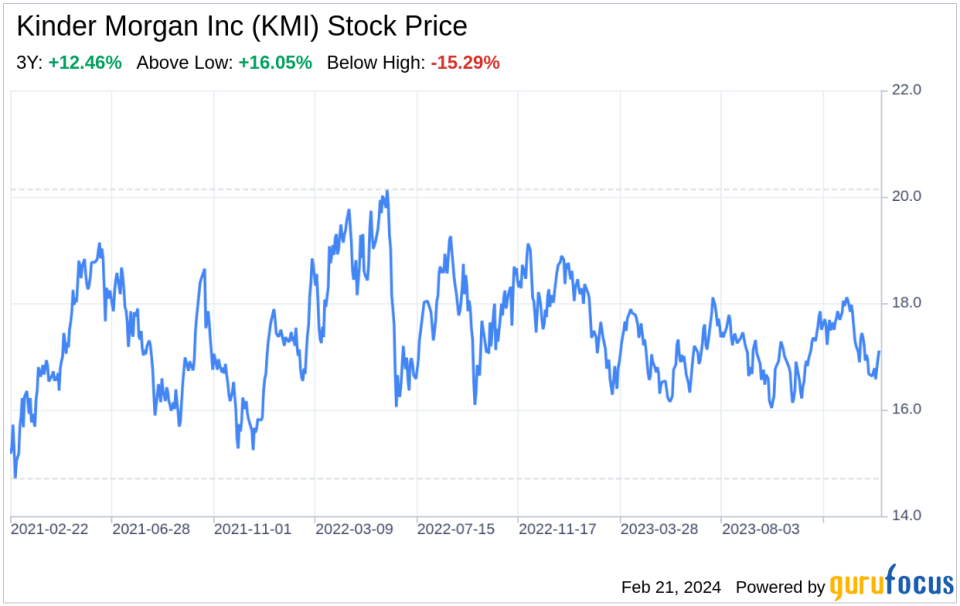Decoding Kinder Morgan Inc (KMI): A Strategic SWOT Insight
Strengths: Robust infrastructure network and strategic market positioning.
Weaknesses: High levels of debt and vulnerability to regulatory changes.
Opportunities: Expansion into renewable energy sectors and technological advancements.
Threats: Market volatility and competitive pressures.
On February 20, 2024, Kinder Morgan Inc (NYSE:KMI) filed its annual 10-K with the SEC, providing a comprehensive overview of its financial health and operational performance for the fiscal year ended December 31, 2023. As one of the largest midstream energy companies in North America, KMI boasts an extensive network of pipelines and storage terminals, which play a pivotal role in the transportation and storage of natural gas, crude oil, and other essential commodities. The financial tables from the filing reveal that KMI has maintained a solid financial foundation, with a market capitalization of approximately $33.5 billion as of June 30, 2023. Despite facing industry-wide challenges, KMI's fee-based contracts continue to generate stable cash flows, reinforcing its financial resilience in a fluctuating market.

Strengths
Extensive Infrastructure Network: Kinder Morgan Inc's vast pipeline and storage infrastructure, encompassing roughly 82,000 miles of pipelines and 139 terminals, positions the company as a critical player in the energy sector. This expansive network enables KMI to cater to a diverse customer base, ensuring a steady flow of revenue. The company's strategic presence in key production areas, such as the Permian Basin and various shale plays, further solidifies its competitive edge, allowing it to capitalize on regional production dynamics and demand.
Fee-Based Revenue Model: The majority of KMI's cash flows are derived from long-term, fee-based contracts, which provide a buffer against commodity price volatility. This business model ensures a predictable and stable income stream, which is crucial for maintaining financial stability and supporting consistent dividend payments to shareholders. In 2023, KMI's financial performance was underpinned by these contracts, demonstrating the company's ability to secure favorable terms and renewals, thereby reinforcing its market position.
Weaknesses
High Debt Levels: As of December 31, 2023, Kinder Morgan Inc reported long-term debt obligations of $27.88 billion, excluding current maturities. While the company's centralized cash management program and cross-guaranty arrangements provide financial flexibility, the high levels of indebtedness could pose a risk in adverse economic conditions. This debt burden may limit KMI's ability to pursue new projects or acquisitions without further leveraging, potentially impacting its long-term growth prospects.
Regulatory and Environmental Compliance Costs: KMI operates in a highly regulated industry, and changes in laws or regulations could increase compliance costs or restrict its ability to provide services. The company acknowledges the potential for increased expenses related to environmental responsibility and safety regulations. These factors could adversely affect KMI's profitability and necessitate significant capital expenditures to maintain compliance, thereby impacting its financial performance.
Opportunities
Expansion into Renewable Energy: Kinder Morgan Inc has the opportunity to diversify its portfolio by investing in renewable energy infrastructure, such as RNG and LNG facilities. As the energy sector transitions towards cleaner sources, KMI's existing infrastructure and expertise could be leveraged to tap into this growing market, potentially opening up new revenue streams and enhancing its long-term sustainability.
Technological Advancements: The company is positioned to benefit from technological innovations, including advancements in carbon capture and sequestration. By adopting new technologies, KMI can improve operational efficiency, reduce environmental impact, and meet the evolving needs of its customers. This proactive approach to technology integration could provide KMI with a competitive advantage in an industry that is increasingly focused on sustainability and efficiency.
Threats
Market Volatility and Economic Conditions: Kinder Morgan Inc's operations are sensitive to fluctuations in the supply and demand for the products it handles. Economic disruptions, changes in commodity prices, and shifts in governmental policies related to climate change could impact the utilization of KMI's assets. The COVID-19 pandemic highlighted the potential for such disruptions to adversely affect the company's financial performance and demand for its services.
Competitive Pressures: KMI faces competition from other pipelines, terminals, and transportation methods, which could offer more attractive options to customers. The emergence of new technologies and competitors in the carbon capture and sequestration space also presents a threat to KMI's traditional CO2 business. To maintain its market share, KMI must continuously innovate and adapt to the changing competitive landscape.
In conclusion, Kinder Morgan Inc (NYSE:KMI) exhibits a robust set of strengths, including its extensive infrastructure network and fee-based revenue model, which provide a solid foundation for its operations. However, the company must navigate weaknesses such as high debt levels and potential increases in regulatory compliance costs. Opportunities for growth lie in the expansion into renewable energy sectors and the adoption of technological advancements. KMI must also remain vigilant of threats from market volatility and competitive pressures. Overall, the company's strategic initiatives and financial prudence position it well to capitalize on industry trends and maintain its status as a leading midstream energy firm.
This article, generated by GuruFocus, is designed to provide general insights and is not tailored financial advice. Our commentary is rooted in historical data and analyst projections, utilizing an impartial methodology, and is not intended to serve as specific investment guidance. It does not formulate a recommendation to purchase or divest any stock and does not consider individual investment objectives or financial circumstances. Our objective is to deliver long-term, fundamental data-driven analysis. Be aware that our analysis might not incorporate the most recent, price-sensitive company announcements or qualitative information. GuruFocus holds no position in the stocks mentioned herein.
This article first appeared on GuruFocus.
